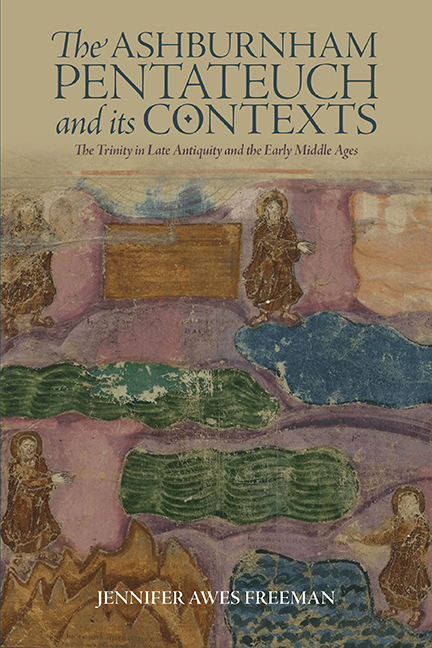Book contents
- Frontmatter
- Dedication
- Contents
- List of Illustrations
- List of Abbreviations
- Introduction: Losing and Finding the Ashburnham Pentateuch
- 1 Early Trinitarian Texts and Debates
- 2 The Trinity in Early Christian Images
- 3 Carolingian Conceptions of the Trinity
- 4 Carolingian Image Theory
- 5 The Carolingian Reception of the Ashburnham Pentateuch
- Conclusion: Possible Motivations for the Ashburnham Pentateuch Erasures
- Coda: The Afterlives of the Ashburnham Pentateuch
- Acknowledgments
- Bibliography
- Index
- ALREADY PUBLISHED
2 - The Trinity in Early Christian Images
Published online by Cambridge University Press: 26 May 2022
- Frontmatter
- Dedication
- Contents
- List of Illustrations
- List of Abbreviations
- Introduction: Losing and Finding the Ashburnham Pentateuch
- 1 Early Trinitarian Texts and Debates
- 2 The Trinity in Early Christian Images
- 3 Carolingian Conceptions of the Trinity
- 4 Carolingian Image Theory
- 5 The Carolingian Reception of the Ashburnham Pentateuch
- Conclusion: Possible Motivations for the Ashburnham Pentateuch Erasures
- Coda: The Afterlives of the Ashburnham Pentateuch
- Acknowledgments
- Bibliography
- Index
- ALREADY PUBLISHED
Summary
In the beginning (of the Ashburnham Pentateuch), God was painted. This particular illustrated Pentateuch presents the God of the Old Testament as the Trinitarian deity of the Christian faith, pictured here (fol. 1v, Plate I) as three men. The sources assessed in Chapter 1 indicate that the Ashburnham Pentateuch's image of the Trinity was consistent with patristic interpretations of the creation of the world as a Trinitarian act. Visualizing the persons of the Trinity as three similar men can be read as a reflection of early Christian doctrinal concerns about the equality of the Son with the Father.
The main task of the present chapter is to investigate how this anthropomorphic image of the Trinity was or was not consistent with other late antique visual depictions of God. First, the Ashburnham Pentateuch's anthropomorphic and symbolic depictions of God will be surveyed. Then the manuscript's Trinitarian image will be situated within the larger context of late antique images of Creation and the Trinity.
THE ASHBURNHAM PENTATEUCH CREATION FOLIO
Before surveying the iconographic context of the Ashburnham Pentateuch's image, two distinct aspects of the image should be clarified: the unusual depiction of the Holy Spirit, and the coupling of the Father and Son. The exact representation of the Holy Spirit is unclear, as its form is now almost completely obscured by paint.
Bezalel Narkiss suggested that the overpainted space and the remnant of the figure's feet, which are barely visible, best accommodate the image of a winged man – an assessment with which I have to concur after personally viewing the distinctly human toes and feet. Verkerk, on the other hand, has argued that it was more likely depicted as a dove, based on iconographic comparanda: most early Christian depictions of the Holy Spirit were in the form of a dove, as in depictions of Christ's baptism. Furthermore, the Holy Spirit was never represented as a winged man in early Christian art. That said, the dove does not seem to have been used in Creation scenes either – although Narkiss points out that the thirteenth-century mosaics at San Marco in Venice, which were based on the late fifth-/early sixth-century Cotton Genesis, present the Holy Spirit as a dove hovering over the waters.
- Type
- Chapter
- Information
- The Ashburnham Pentateuch and its ContextsThe Trinity in Late Antiquity and the Early Middle Ages, pp. 34 - 60Publisher: Boydell & BrewerPrint publication year: 2022



